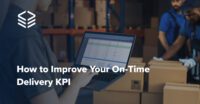
Technology has significantly changed the shopping landscape, thereby causing the roles of distributors, wholesalers, and retailers to shift as well. Modern consumers are able to shop and make purchases within minutes from the palms of their hands. In many cases, goods are received within two days, if not the same day, packaged and waiting to be picked up in-store or delivered straight to a shopper’s front door.
Where and from whom consumers are shopping has also shifted as well. The typical ecommerce fulfillment flow once involved retailers buying their inventory from wholesalers, who would purchase a larger volume of products from distributors. The distributors’ buys would trickle down to smaller orders until products were available for customers on the shelves or from an ecommerce store.
This fundamental system is still in place. However, many well-recognized companies are reducing their reliance on the middle layers and selling directly to consumers. To better understand the evolving relationship between retailer vs wholesaler vs distributor, it’s important to first look at the main differences.
Differences Between Retailers, Wholesalers, and Distributors
Inventory volume
Essentially, in a 1:1 model, retailers sell to consumers, wholesalers sell to retailers, and distributors sell to wholesalers. Retailers buy small quantities of select items from a distributor or wholesaler. Wholesalers buy a large quantity and variety of products directly from the distributor. Together, they form a relationship to maintain a steady inventory flow at both ends.
Pricing structure
In addition to a difference in inventory volume, wholesalers also purchase products from distributors at a discount. There is typically a mutually agreed-upon number of items purchased or total spend on each order to receive the savings. This may apply to a single category, such as electronics, or expand to a broader area like home goods, depending on retailer purchasing history.
Accessible inventory
From this broad selection of products, retailers then curate their stores based on what their customers buy most. They use consumer data to replenish the products in the highest demand and work with wholesalers that can provide the most competitive pricing. Another main difference with how each part of the supply chain works depends on the business model the company has set up.
How the Retailer-Wholesaler Relationship Varies Between Big Box and Individual Brands
Big box retailers that offer a wide variety of items often work with distributors that can meet their consistent, high-volume orders, whereas individual brands may find it more cost-effective and consumer-friendly to sell direct. For example, Nike recently started to reduce its wholesale relationships and eliminate the middle sales channel by selling directly to consumers.
Due to its strong brand identity and loyal customer base, Nike can maintain complete control over the fulfillment process and take a more efficient, customer-centric approach that increases profit margin. Though it’s likely even the biggest name brands won’t leave wholesale options completely, this new hybrid model gives consumers what they want: options.
For some customers, the convenience of going to their local athletic footwear store and browsing Nike sneakers is their ideal buying scenario, while others prefer the customization options Nike offers online and are willing to wait until they find the perfect shoe.
Consumer Benefits of Buying from a Retailer
The way consumers are shopping today doesn’t follow an either/or structure, but rather provides options for all possibilities. In short, an ecommerce business doesn’t need to fully abandon its current operational methods. The idea is to expand upon them and customize them per their customer base. There are advantages to both. Here are a couple of the benefits of buying from an ecommerce brand retailer.
Curated Shopping Experience
Retail shopping provides a curated experience for consumers. A store’s customers can compare the pricing and quality of products side-by-side before making a purchase, either in person or online. With ecommerce setups, there are also personalized selections displayed based on a customer’s recent shopping activity. This helps brands upsell their merchandise and make it a more customized experience for the consumer.
Personal Connection with the Brand
A benefit of buying directly from a brand is it provides a personal connection, particularly if the retailer invests in custom branded packaging. Customers build trust in brands, knowing what to expect when it comes to quality, price, and consistent delivery of products. In return, this helps build stability for brands and allows them to create more targeted marketing campaigns based on their audience’s preferences and buying behavior.
Consumer Benefits of Buying Wholesale
Shopping directly from brand retailers focuses on customization, a deciding factor for consumers today. Benefits of buying wholesale, however, include cost-effectiveness and convenience, which also play a big role in purchase behavior. Here are a couple of ways consumers choose to buy wholesale.
Lower Sales Prices
Buying directly from a wholesale distributor carries the significant advantage of lower costs than what is often found in a third-party retail store. By cutting out the retailer, additional transportation costs and markups are reduced, allowing for merchandise to be sold in bulk at a reduced price point.
Greater Product Availability
A big differentiator between retailers vs wholesalers is the volume of merchandise available at any given time. A wholesaler buys mass quantities of products chosen by their retail business partnerships, personal consumers, or both. Therefore, there’s a greater quantity of inventory typically available in stock. There’s a risk of stockouts when buying from a retailer, particularly when there are spikes in sales, like during the peak holiday season.
Optimizing the Consumer Experience, Starting with the Supply Chain
When it comes to adapting to the consumer shopping experience, customization is the winning factor, though determining how to scale to meet customer demands and preferences can be a challenge.
Fortunately, there are several ways to optimize the buying experience for customers, and it begins with a flexible and customer-driven supply chain strategy. There are five key areas of focus that, when combined, will lead to the optimized customer experiences that build brand loyalty, amplifying customer lifetime value as they continue to repurchase.
1. Network Optimization
A critical piece of supply chain design is an optimized fulfillment network. The closer a product is to a consumer, the faster it can be delivered. The Flowspace network encompasses hundreds of fulfillment centers across the country, all connected by proprietary software. Flowspace’s network optimization algorithm identifies optimal fulfillment centers closest to a brand’s customers, creating efficiency and enabling consistently fast fulfillment, affordably.
2. Omnichannel Order Management
Where and how goods are sold is another key consideration for brands looking to meet the demands of today’s consumers. Meeting consumers where and when they’re shopping, is a key consideration for shoppers seeking convenience, as is consistently quick and seamless product delivery, no matter the order source. Omnichannel order management systems ensure all orders are tracked and fulfilled, no matter where they come from, or where they’re sent.
3. Inventory Planning
Learning how to overcome supply chain disruptions can be a matter of trial and error, however, with proper inventory planning, companies are better able to forecast inventory needs with confidence. Using integrated platforms to analyze inventory on a real-time basis leads to more accurate scheduling of replenishment needs. Implementing inventory tracking across the supply chain also allows companies and their consumers to know where their products are in transit, and when they will arrive.
4. Real-Time Visibility
Many retailers choose a hybrid solution of operating brick-and-mortar store locations and an ecommerce storefront. With multiple storefronts, shopping carts, and marketplaces to keep track of, it’s essential to have real-time visibility of all activity. This interconnectivity ensures there’s enough inventory, provides current sales information and fluctuations, and delivers relevant information to the customer service teams to handle order inquiries with ease.
5. Customer Insights
In order to truly implement the customization consumers want, companies must know and understand their customers. Customer analytics and insights into buying behavior, lifetime value, and individualized preferences are needed for brands to scale and grow. This data supports predictive analysis of buying trends and helps to forecast future sales.
Values of the Retailer vs Wholesaler vs Distributor Roles
Though the roles of distributors, wholesalers, and retailers continue to shift based on how consumers are shopping today, each remains an important piece of supply chain operations. In the past, the presence of wholesalers or distributors wasn’t as significant to the consumer side as retailers were. However, consumers are tuned in now more than ever due to technology connecting them directly with their orders.
They value transparency. With technology, consumers can track items as they leave the warehouse, when they’re on the truck out for delivery, or in the hands of a driver heading for their front door.
They also value agility and sustainability. Optimizing the supply chain network and ensuring reliable supplier relationships is important. It allows companies to maintain a competitive advantage of delivering goods to consumers in the way they want to receive them. Furthermore, with the focus on sustainability and the environmental impact of traditional supply chain models, companies are looking for new ways to reduce their carbon footprint and manufacturing and deliver goods in an ethical and sustainable way.
There are far greater expectations from consumers today. Companies that maintain supplier diversity and uphold real-time communication can quickly pivot as needed to make sure these are upheld. Staying connected and up-to-date on changes within the industry, as well as the fluctuations in demand will help companies provide a satisfactory experience for their customers.
Want to learn more about streamlining your supply chain and tailoring a fulfillment solution for your company? Contact us today.
Sources:
- Chron. Differences Between Wholesalers, Distributors, and Retailers. https://smallbusiness.chron.com/differences-between-wholesalers-distributors-retailers-30836.html
- RetailWire. Wholesale curtailed. Is retail’s favorite model faltering? https://www.retailwire.com/discussion/wholesale-curtailed-is-retails-favorite-model-faltering/
- Bright Pearl. Retail vs. Wholesale: Understanding the Differences of Each. https://www.brightpearl.com/sales-channel-strategy/retail-vs-wholesale
- CMSWire. What Customer Experiences Look Like in the 2021 Supply Chain. https://www.cmswire.com/customer-experience/what-customer-experience-looks-like-in-the-2021-supply-chain/







